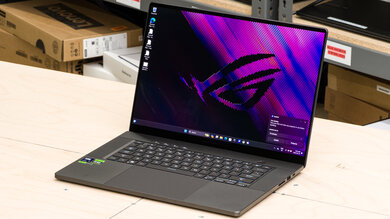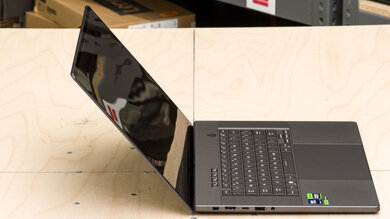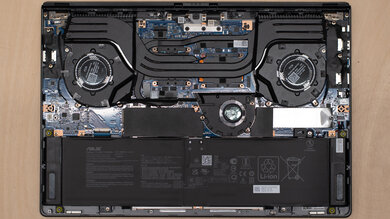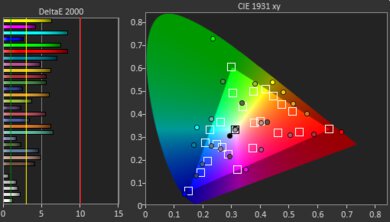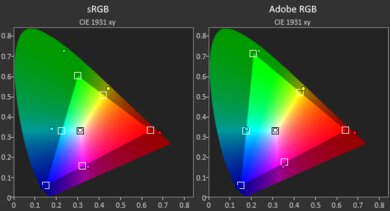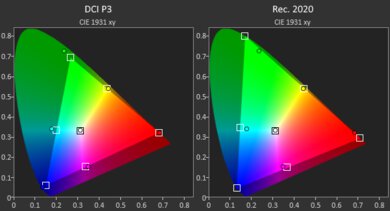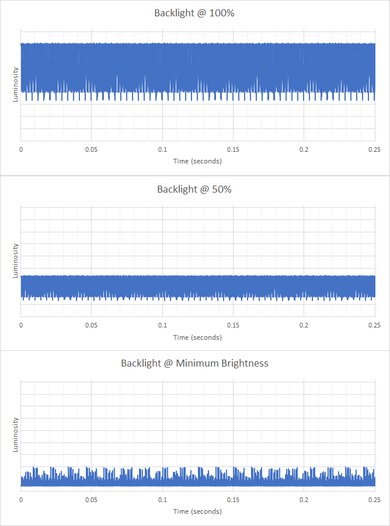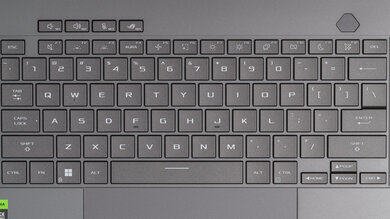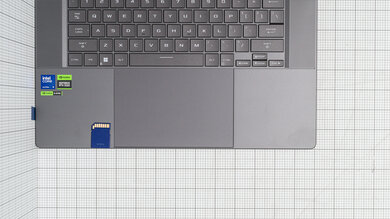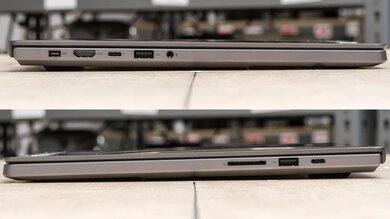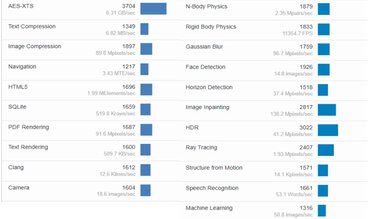The ASUS ROG Zephyrus G16 (2024) is a high-end 16-inch gaming laptop. It replaces the ASUS ROG Zephyrus G16 (model GU603) from 2023. This 2024 GU605 model is available with Intel Meteor Lake CPUs and NVIDIA 40-series discrete GPUs, up to a Core Ultra 9 185H and RTX 4090, respectively. You can get up to 32GB of RAM and 2TB of storage—only the latter is user-replaceable. There's an IPS and OLED panel option; both are QHD+ displays with a 240Hz refresh rate and G-SYNC support. Ports include two USB-As, two USB-Cs (one Thunderbolt 4), an HDMI 2.1, a full-size SD card reader, and a 3.5 mm headphone jack.
See our unit's specifications and the available configuration options in the Differences Between Variants section.
Our Verdict
The ASUS ROG Zephyrus G16 is good for school use. It's fairly portable for a 16-inch device, and it provides a great user experience with its sharp display, comfortable keyboard, and large touchpad. Available with Intel Meteor Lake CPUs and NVIDIA 40-series discrete GPUs, it has plenty of processing power to handle demanding tasks, making it suitable for students in fields like programming, game development, and 3D graphics. The main downside is its short six-hour battery life in light uses.
- Fairly portable for a 16-inch laptop.
- Sharp OLED display.
- Comfortable keyboard, large touchpad.
- CPU and GPU can handle demanding tasks.
- Wide port selection.
- Battery doesn't last through a typical eight-hour day of light use.
- OLED susceptible to permanent burn-in.
The ASUS ROG Zephyrus G16 is an excellent gaming laptop. You can get this laptop with an IPS or OLED display; both have a 240Hz refresh rate, a fast response time, and G-SYNC support, giving you an amazing visual experience with clear images in fast-moving scenes. This laptop is available with powerful Intel Meteor Lake CPUs and NVIDIA 40-series discrete GPUs. Its overall performance is great; however, there are a few bugs causing lower-than-expected frame rates in some games (at the time of writing). RAM and storage max out at 32GB and 2TB, respectively; the former isn't user-replaceable, but the latter is.
- Delivers smooth gameplay in most games at 1080p or 1440p.
- 240Hz display with fast response time.
- VRR support to reduce screen tearing.
- Wide port selection.
- Fast, user-replaceable SSD.
- Inconsistent performance.
- Soldered RAM.
The ASUS ROG Zephyrus G16 is great for media consumption. It's fairly portable, and its battery lasts over six hours of video playback. Its 16-inch display looks sharp and has a fast response time to deliver a clear image in fast-moving content. You can choose between an IPS or OLED panel; the latter is better suited for dark rooms, as it produces much deeper blacks. Both displays get bright enough for use in most indoor settings. The speakers sound clear and full, with a good amount of bass. They get very loud, though there are noticeable compression artifacts at higher volume levels.
- Fairly portable for a 16-inch laptop.
- Sharp OLED display.
- Battery lasts over six hours of video playback.
- Loud speakers.
- Speakers sound clear and full, with a good amount of bass.
- Speakers exhibit noticeable compression at high volume levels.
- OLED susceptible to permanent burn-in.
The ASUS ROG Zephyrus G16 is outstanding for use as a workstation. It's available with high-performance Intel CPUs and NVIDIA GPUs that can easily handle demanding tasks like video editing and 3D graphics. Its 16-inch display gives you plenty of screen real estate for multitasking, and it's suitable for color work, sporting full DCI P3 and Adobe RGB coverage. Its wide port selection includes plenty of USB ports, an HDMI 2.1, and a full-size SD card reader, allowing you to easily connect peripherals and external displays. The SSD is user-replaceable, and there's even a second slot if you want to add more. Unfortunately, you can only get up to 32GB of soldered RAM, which might not be enough for highly demanding workloads.
- CPU and GPU can handle demanding tasks.
- Display is suitable for content creation.
- Wide port selection.
- Fast, user-replaceable SSD.
- Inconsistent performance.
- Can only support up to 32GB of soldered RAM.
- OLED susceptible to permanent burn-in.
The ASUS ROG Zephyrus G16 is great for business use. It feels very well-built and provides a great user experience with its large display, comfortable keyboard, and large touchpad. Its Intel CPU and discrete NVIDIA GPU can easily handle productivity tasks like web browsing, text formatting, and spreadsheets. You can even edit photos and videos, which is great for small business owners needing to do a little bit of everything. It has a wide port selection for peripherals and external displays and a facial recognition IR camera for quick logins. It isn't overly bulky or heavy for a 16-inch device, though you'll need to carry a charger, as the battery lasts only around six hours of light use.
- Fairly portable for a 16-inch laptop.
- Sharp OLED display.
- Comfortable keyboard, large touchpad.
- Wide port selection.
- Decent 1080p webcam.
- Battery doesn't last through a typical eight-hour day of light use.
- OLED susceptible to permanent burn-in.
Changelog
-
Updated Aug 12, 2025:
Added mention of the Gigabyte AORUS MASTER 16 (2025) as an alternative with NVIDIA 50-series GPUs in the GPU section.
- Updated May 07, 2025: We've updated this review to Test Bench 0.8.3, which removes the viewing angle tests and adds a GPU Total Graphics Power comparison in the GPU section. The Pen Input test in the Extra Features section has also changed, as it now shows whether the laptop supports pen input rather than the inclusion of a stylus in the box. See the changelog for more details.
-
Updated Oct 18, 2024:
Added mention of the Razer Blade 18 (2024) as an alternative with a larger display in the Screen Specs section.
- Updated Sep 26, 2024: Added mention of the ASUS ROG Strix G16 (2024) as an alternative with more powerful CPU options in the CPU section.
Check Price
Differences Between Sizes And Variants
We tested the ASUS ROG Zephyrus G16 (model GU605MI-DS91-CA) with a 240Hz QHD+ OLED display, an Intel Core Ultra 9 185H CPU, an NVIDIA GeForce RTX 4070 discrete GPU, 16GB of RAM, and 1TB of storage. The display, CPU, GPU, RAM, and storage are configurable; the available options are in the table below.
| Screen |
|
|---|---|
| CPU |
|
| GPU |
|
| Memory |
|
| Storage |
|
| Color |
|
See our unit's label here.
Popular Laptop Comparisons
The ASUS ROG Zephyrus G16 is an excellent gaming laptop overall. It stands out for its sturdy build, nice OLED display, comfortable keyboard, and wide port selection. However, its performance is inconsistent due likely to software issues (at the time of writing). Also, it's only available with up to 32GB of soldered RAM, which might not be enough if you want to use it as a workstation for highly demanding tasks.
See our recommendations for the best gaming laptops, the best budget and cheap gaming laptops, and the best laptops for video editing.
The ASUS ROG Strix G16 (2024) and the ASUS ROG Zephyrus G16 (2024) GU605 are both high-end gaming laptops. Both offer excellent performance and have complementary features. The Strix has a faster CPU, which means it's better for workstation applications, while the Zephyrus has a better user experience overall with a superior OLED display, keyboard, and touchpad. Unfortunately, the Zephyrus suffers from a hardware bug; it isn't able to fully utilize its GPU even though it's never CPU-limited.
The Lenovo Yoga Pro 9i 16 (2024) and the ASUS ROG Zephyrus G16 (2024) GU605 are both 16-inch Windows laptops with Intel Meteor Lake CPUs and NVIDIA 40-series GPUs. The Lenovo is a productivity/content creation laptop, while the ASUS is primarily a gaming model but can also serve as a creator laptop. These two models trade blows, so the choice comes down to what you care about most. Naturally, the ASUS is a better choice for gaming since it has an OLED display with a faster refresh rate and VRR support, and it's available with higher-end GPUs, up to an RTX 4090. Just remember that OLEDs are susceptible to permanent burn-in, which is more of a problem when using the laptop for productivity tasks, as there are typically more static elements present on the screen than when gaming.
While the Apple MacBook Pro 16 (M4, 2024) and ASUS ROG Zephyrus G16 (2024) GU605 are powerful 16-inch laptops, they're designed for different purposes. The ASUS is a gaming laptop with gaming-focused features, while the Apple is a premium mobile workstation. The Apple laptop's user experience is better overall, thanks to its superior build quality, a brighter and more color-accurate display, a larger haptic touchpad, and better-sounding speakers. The ASUS is still well-built; it can't compete with Apple's industry-leading design and build. While the M4 Max SoC is faster than the Intel Meteor Lake CPUs found on the ASUS, the ASUS has the Apple beat in terms of discrete GPU options; it comes with up to an NVIDIA GeForce RTX 4090 laptop GPU that vastly outperforms the M4 in gaming. Otherwise, the ASUS's 240Hz OLED display has a much faster response time than the Apple's 120Hz Liquid Retina XDR display, giving you a clearer image in fast-paced games, and it supports G-SYNC to minimize screen tearing.
The ASUS ROG Zephyrus G16 (2024) GU605 and the ASUS ROG Zephyrus G14 (2024) are both great gaming laptops. The main difference is that the G16 is a larger model available with more powerful GPUs (up to an RTX 4090) and a higher-refresh 240Hz display, while the G14 is a more compact and portable model configurable with up to an RTX 4070 GPU and a 120Hz display. As for performance, although the G16 is better overall (higher wattage GPUs, superior cooling system), there are a few bugs at the time of writing, causing lower-than-expected frame rates in some games.
Test Results

The ASUS Zephyrus G16 is available in a Platinum White or Eclipse Gray color. The diagonal bar on the lid called 'Slash Lighting,' contains LED lights. You can customize the lighting via the ASUS Armoury Crate app. See the bottom of the laptop here.
The ASUS ROG Zephyrus G16's build quality is outstanding. Its aluminum chassis feels very sturdy, exhibiting little to no flex on the lid or keyboard deck. There's also very little twist when manipulating the display. The finish is fairly scratch-resistant and doesn't pick up too many fingerprints or smudges. The feet feel solid and stick firmly to the bottom.
Accessing the internals is relatively straightforward; you only need to remove nine screws and two spacers (not glued on). The bottom panel comes off pretty easily—a prying tool isn't necessary. Both storage slots support M.2 2280 PCIe Gen 4 NVMe SSDs.
Get the user manual here.
The ASUS ROG Zephyrus G16 2024 is available with the following displays:
- 16" IPS 2560 x 1600 240Hz (Glossy, 100% DCI P3)
- 16" OLED 2560 x 1600 240Hz (Glossy, 100% DCI P3)
Both displays look very sharp—not quite as sharp as the ASUS ROG Zephyrus G14 (2024)'s 2.8k (241 PPI) panel, but still more than adequate for gaming, general productivity, and content creation. The 16:10 aspect ratio is great for productivity, as it gives you slightly more vertical space than a standard 16:9 screen, allowing you to see more information at once when reading a document or website. The main difference between the two displays is the panel type—the OLED panel produces deeper blacks, making it a better option for dark room viewing, but unlike the IPS panel, it's susceptible to permanent burn-in, especially with static elements like Windows' taskbar. That said, it's unlikely to be an issue for those viewing varied content. Check out the Razer Blade 18 (2024) if you want a laptop with an even larger display for a more immersive gaming experience.
The ASUS ROG Zephyrus G16 2024's OLED display has a high refresh rate and a fast response time, resulting in a clear image in fast-moving scenes and exceptional input responsiveness. The IPS panel is likely identical in performance, as it has the same refresh rate and advertised response time.
The OLED display's contrast ratio is effectively infinite since OLEDs can turn off individual pixels to produce perfect blacks. The IPS panel has a much lower contrast ratio, as it's a backlit display with no local dimming capability. This means blacks will look more like gray in dim settings.
The OLED display gets bright enough for use in most indoor settings but not outdoors in broad daylight. It's very dim at the lowest brightness setting, which is great for dark room viewing as it causes less eye strain. The IPS panel has the same advertised brightness.
The display's glossy finish handles reflections remarkably well. Reflections are only problematic when viewing dark-color content. Bright reflections, like a lamp, are visible when viewing light-color content with the screen at max brightness, but they aren't overly distracting.
The OLED panel's black uniformity is perfect since OLEDs can turn off individual pixels. As for the IPS panel, while backlight bleed is possible, it's unlikely to be a common issue, especially on a high-end device such as this. That said, blacks will look more like gray since the IPS panel has a backlight with no local dimming capability.
The display's accuracy is good out of the box. The white balance inaccuracies are minor and hard to spot, but many colors are visibly off due to oversaturation. Some people may like this punchy, oversaturated look; just know it isn't accurate. The gamma follows the curve well at mid-brightness; however, dark scenes are a tad too dark, and bright scenes are too bright.
The display's color gamut is superb. It has full coverage of the sRGB and DCI P3 color spaces and near-full coverage of the Adobe RGB color space, making it suitable for a wide range of uses, including media consumption, professional photo editing, and HDR video production. The IPS panel has the same advertised color gamut.
The ASUS ROG Zephyrus G16 has an excellent keyboard. Its layout feels spacious and is easy to get used to. The keys have a good amount of travel, require little force to actuate, and provide clear tactile feedback. Some keys wobble, but in general, most are relatively stable. Unfortunately, although this keyboard has RGB backlighting, there's only one lighting zone, so customization is limited. You can change the lighting in the ASUS Armoury Crate software.
The ASUS Zephyrus G16 2024 has an excellent touchpad. It's large, and its surface feels smooth, allowing fingers to slide easily across it. Tracking is excellent, except around the left and right edges, where it feels a tad less responsive. Palm rejection works as intended, and there are no issues performing gestures like dragging and dropping. You can only click in the bottom half of the touchpad; the buttons feel tactile.
The speakers sound clear and full, with a good amount of bass and treble. They get very loud, though there's a fair amount of compression at higher volume levels.
The ASUS Zephyrus G16 has a decent webcam. The image looks detailed; however, the colors are a tad oversaturated and overly warm. There's also noise in some areas. As for the microphone, although voices come across clearly, there's static noise in the background.
The ASUS Zephyrus G16 2024 has an outstanding port selection. Both USB-As support USB 3.2 Gen 2 data transfer speed of up to 10Gbps. The two USB-Cs are different in specifications; the one on the left (next to the HDMI port) supports Thunderbolt 4 (up to 40Gbps data transfer speed), while the right one supports USB 3.2 Gen 2. Both USB-Cs support DisplayPort 1.4 and Power Delivery. You can charge the laptop via USB-C, but only up to 100W, so the battery will discharge if you use the laptop for intensive tasks while charging.
The wireless adapter is an Intel AX211NGW. Wi-Fi 6E gives you access to the 6GHz band, providing faster speeds, lower latency, and less signal interference than previous wireless standards; however, you need a router that supports Wi-Fi 6E to benefit from these features.
The ASUS ROG Zephyrus G16 is available with the following CPUs:
- Intel Core Ultra 7 155H (16 cores/22 threads, up to 4.8GHz, 24MB cache)
- Intel Core Ultra 9 185H (16 cores/22 threads, up to 5.1GHz, 24MB cache)
Both are high-performance CPUs from Intel's Meteor Lake family. Unlike Intel's 14th Gen processors (13th Gen Raptor Lake refreshes), these CPUs have two additional low-power E-cores (LP-E) to further improve efficiency and an NPU (Neural Processing Units) to handle AI-based tasks, like background-blurring on video calls. They can easily handle general productivity tasks and more demanding workloads like gaming, programming, and video editing. The Core Ultra 7 and Core Ultra 9 have the same core composition, meaning they both have six performance cores, eight efficiency cores, and two low-power efficiency cores (6P+8E+2LP-E). The only difference is that the Core Ultra 9 has faster clock speeds, which typically results in only a small performance boost. Both CPUs have the same Neural Processing Units (NPU). If you want a gaming laptop with more powerful CPU options, consider the ASUS ROG Strix G16 (2024).
The ASUS ROG Zephyrus G16 is available with the following CPUs:
- NVIDIA GeForce RTX 4050 Laptop GPU 6GB GDDR6 (100W TGP /w Dynamic Boost)
- NVIDIA GeForce RTX 4060 Laptop GPU 8GB GDDR6 (100W TGP /w Dynamic Boost)
- NVIDIA GeForce RTX 4070 Laptop GPU 8GB GDDR6 (105W TGP /w Dynamic Boost)
- NVIDIA GeForce RTX 4080 Laptop GPU 12GB GDDR6 (115W TGP /w Dynamic Boost)
- NVIDIA GeForce RTX 4090 Laptop GPU 16GB GDDR6 (115W TGP /w Dynamic Boost)
The available GPUs range from entry-level (RTX 4050) to the top-end RTX 4090. All five have the same features, meaning they all support DLSS 3 (including frame generation), ray tracing, and NVIDIA Reflex, so you aren't losing any features if you get a lower-end model. If you plan on gaming at the display's native QHD+ resolution, getting an RTX 4080 or 4090 is best, as the RTX 4060 and 4070's 8GB VRAM is limiting at the QHD resolution. You can even experience performance issues like stutters and graphical pop-ins with 8GB of VRAM at 1080p, depending on the game. This isn't to say that you should avoid the RTX 4060 and 4070; just know that you'll run into issues sooner as newer games become increasingly demanding. As for the RTX 4050, this GPU is mainly for 1080p gaming, though it can handle some well-optimized or lighter titles (like platformers) at 1440p. Check out the Gigabyte AORUS MASTER 16 (2025) if you want a gaming laptop with NVIDIA 50-series GPUs, which support Multi-Frame Generation.
See more details about NVIDIA's 40-series laptop GPUs here.
You can get this laptop with 16GB or 32GB of RAM. The memory isn't user-replaceable.
You can get the ASUS ROG Zephyrus G16 2024 with 1TB or 2TB of storage. Some RTX 4080 and 4090 models include a Western Digital 'Performance' SSD, which is presumably faster than the SSD in other configurations; however, ASUS doesn't specify the exact model of the 'Performance' SSD. You can get this laptop with 1TB or 2TB of storage. The SSD is user-replaceable. There are two storage slots; both support M.2 2280 PCIe Gen 4 NVMe SSDs.
The ASUS ROG Zephyrus G16's overall score in Geekbench 5 is outstanding. Its Intel Core Ultra 9 185H CPU can handle a variety of productivity tasks and heavy multitasking. That said, there are significantly faster CPUs on the market, like the Dell Alienware m18 R2 (2024)'s Intel Core i9-14900HX. The posted results are averages obtained in the default Performance mode. Switching to the Turbo mode boosts the multi-thread score to 14,482, about a 13% performance increase. The Core Ultra 7 155H CPU is only slightly slower.
As for the GPU, the NVIDIA GeForce RTX 4070 (mobile) performs well, scoring within the expected range. The Ultimate GPU mode boosts performance by about 6%, increasing the score to 134,191. All available discrete GPUs can handle demanding computing tasks, so it's just a matter of how smooth an experience you expect and how fast you want to complete tasks.
The ASUS ROG Zephyrus G16 scores remarkably well in the Cinebench R23 benchmark. Its Intel Core Ultra 9 185H CPU can easily handle intensive, multi-threaded applications and heavy multitasking. Switching to the Turbo mode raises the multi-thread score to 18,766, roughly a 7-8% performance increase. The Core Ultra 7 155H is only slightly slower due to its lower clock speeds.
The ASUS ROG Zephyrus G16 with an NVIDIA GeForce RTX 4070 Laptop GPU scores remarkably well in the Basemark GPU benchmark. Again, the posted result is the average obtained in the default mode. Switching to the Ultimate GPU mode increases the score to 137,527, a 10% performance increase. As mentioned in the GPU section, the RTX 4060, 4070, 4080, and 4090 can handle gaming at 1080p and 1440p; however, you'll have to dial down the graphical settings a bit when playing at 1440p on the RTX 4060 and 4070 models to get high, consistent frame rates. The entry-level RTX 4050 is mainly for 1080p gaming.
The web browsing and video playback results are numbers obtained by forcing the laptop to use only the CPU's integrated graphics. Setting the laptop in its default 'Hybrid' mode, which automatically switches between the integrated and discrete GPUs depending on the task, shortens the battery life to 4.1 hours in light uses (web browsing) and 4.5 hours for video playback.
The ASUS ROG Zephyrus G16's performance in Borderlands 3 is okay. The Intel Core Ultra 9 185H/NVIDIA GeForce RTX 4070 system can reach good frame rates at 1080p with high settings, but there are noticeable stutters due to frame drops. Unlike the productivity benchmarks, switching the GPU to the Ultimate mode doesn't seem to affect the performance noticeably in games, boosting the average frame rate by only 1 fps with high settings. There isn't much performance difference in the other modes either, an issue many online users have reported. It's also worth noting that the numbers are low for this RTX 4070 configuration. This is because the GPU rarely reaches 100% utilization even though the system isn't CPU-bound, instead sitting around 80% utilization or less. Thankfully, this issue doesn't affect all games. We'll update the review if anything changes.
Here are some additional benchmarks to give you a better idea of the performance:
- Borderlands 3
- QHD+, high settings, Ultimate (GPU): 70 fps
- QHD+, very low settings, Ultimate (GPU): 118 fps
- Red Dead Redemption 2
- FHD+, Quality preset (favor quality), Ultimate (GPU): 64 fps
- FHD+, Lowest preset (favor performance), Ultimate (GPU): 117 fps
- QHD+, Quality preset (favor quality), Ultimate (GPU): 49 fps
- QHD+, Lowest preset (favor performance), Ultimate (GPU): 93 fps
Every configuration of the ASUS ROG Zephyrus G16 can run Civilization VI and other similar games smoothly at 1080p or 1440p. That said, the average frame rates are lower than expected, as there are software bugs limiting the GPU utilization.
Counter-Strike 2 runs well on the ASUS Zephyrus G16. While there are some noticeable stutters caused by frame drops, they don't happen all that often. Every configuration can run this game smoothly at 1080p or 1440p, but again, the average frame rate is lower than expected for this Core Ultra 9/RTX 4070 configuration.
Shadow of the Tomb Raider runs well. However, the numbers are, again, lower than expected for this Core Ultra 9/RTX 4070 configuration. The large frame spikes are scene changes and aren't representative of the performance. Here are the average frame rates at the display's native QHD+ resolution with the GPU set to the Ultimate mode:
- Avg. FPS, high preset: 90 fps
- Avg. FPS, low preset: 108 fps
The keyboard deck gets pretty hot under load; however, the hot spot is closer to the top, away from where most people rest their hands. The fans are relatively quiet at full speed and aren't overly bothersome. Models with an RTX 4080 and 4090 have a vapor chamber instead of a third fan, so they'll likely produce less noise.
The ASUS ROG Zephyrus G16 2024 has a few pre-installed applications, including:
- ASUS Armory Crate: Lets you monitor the system status, change performance settings, create macros/hotkeys, customize the lighting (lid and keyboard), as well as access gaming news and the ASUS online shop.
- GlideX: Lets you mirror your screen's content to a smartphone, tablet, or computer.
- McAfee: Antivirus software. Requires subscription.
- MyASUS: Lets you connect your smartphone for file transfers, customer support, and power settings.
- Solitaire & Casual Games: Solitaire, FreeCell, Spider, Mahjong, Sudoku, and other casual games.
The ASUS Zephyrus G16 2024 has a Windows Hello facial recognition camera. You can use it to log into Windows, authorize purchases on the Windows Store, or auto-fill saved passwords on supported websites.

